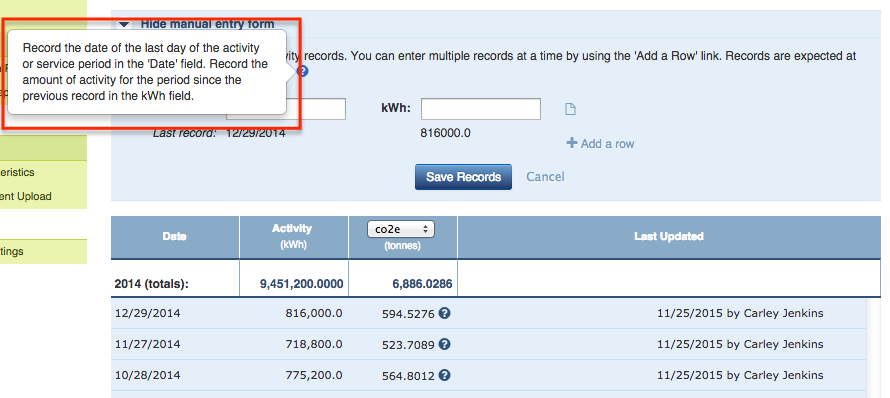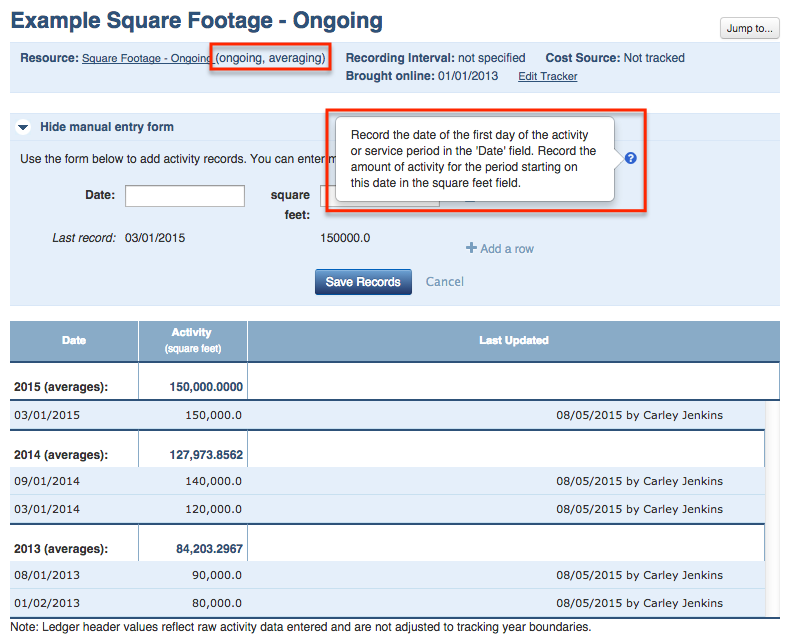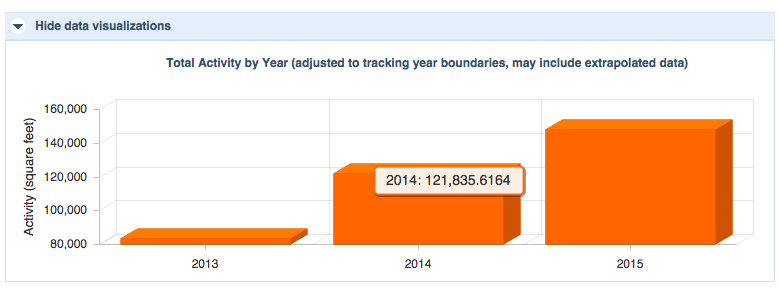Two important attributes of a tracker control the manner in which Scope 5 interprets activity records in the tracker's ledger. These attributes are not directly configured in the tracker. Rather, they are inherited from the resource that the tracker tracks. One of these attributes is the temporal aggregation method which determines whether the activity records are summed or averaged over time. The other attribute controls how the dates on the activity records are interpreted and can be accrual or ongoing. This second attribute is the topic of this article.
Accruing Trackers
Most trackers that track the consumption or generation of a resource (electricity, fuel, waste, units produced, etc.) should be configured as accruing. It's helpful to think of using accruing trackers when the amount of activity is known retrospectively and not a-priori. This is the case with most utility bills that inform the customer the activity that was incurred over a service period in the past.
The image below illustrates the activity ledger for a typical accruing electricity tracker. One activity record is recorded for each service period billed. Each record quantifies electricity used over a service period ending on the record date and starting the day after the previous record date (the end of the previous service period):
- The record dated 12/29/2014 tells Scope 5 that 816,000 kWh of electricity was used over the service period starting on 11/28/2014 and ending on 12/29/2014.
- The record dated 11/27/2014 tells Scope 5 that 718,800 kWh of electricity was used over the service period starting on 10/29/2014 and ending on 11/27/2014.

In summary, when recording activity data for an accruing tracker, you should record the activity that accrued over the period starting on the day after the previous activity record and ending on the current record's date. This is explained in the tooltip in the manual entry form (highlighted in the image above).
Ongoing Trackers
Ongoing trackers are used to tell Scope 5 about activity that is known a-priori. Facility area is one example of activity for which ongoing trackers should be used. Activity records for ongoing trackers tell Scope 5 that on the day of the record date, the activity changed to the value indicated and it remains at that value until further notice (until the next activity record date).
The sample ongoing tracker ledger below tells Scope 5:
- On 1/2/2013 this facility's area was 80,000 sq. ft.
- On 8/1/2013 the facility's area changed to 90,000 sq. ft.
- On 3/1/2014 the facility's area changed to 120,000 sq. ft.
- On 9/1/2014 the facility's area changed to 140,000 sq. ft.
- On 3/1/2015 the facility's area changed to 150,000 sq. ft. and remains at that level indefinitely (until further notice)

This tracker is configured as ongoing, but also as averaging. As such, the tracker page column charts below illustrate the average square footage for each year, based on the activity records illustrated above. The average square footage for 2014 for example, is calculated by taking the weighted average of the three different facility areas in 2014:
- The first 59 days of the year at 90,000 sq. ft.
- The 184 days starting on 3/1 until the area changed again on 9/1 at 120,000 sq. ft.
- The last 122 days of the year from 9/1 through 12/31 at 140,000 sq. ft.
((59 * 90,000) + (184 * 120,000) + (122 * 140,000))/365 = 121,835.6164

But now we're starting to get into a discussion of averaging vs. summing trackers - a discussion for a separate article.
Activity Record Dates
Keep the following guidelines in mind when thinking about recording activity:
- When recording activity for accruing trackers, the activity recorded should be for the period starting the day after the previous record's date and ending on the date of the current record.
- When recording activity for ongoing trackers, the activity recorded should be for the period starting on the date of the current record and ending the day before any subsequent record (if it exists).
In both cases, the current record's date is said to be inclusive. The previous (accruing) or following (ongoing) record's date is not.
Boundary Conditions
When we described accruing trackers, we identified the start of a record's service period as the day after the previous record date. But the earliest activity record in the ledger has no previous record. What is the start of this record's service period? The answer is that it depends. Generally, Scope 5 will assume that the service period corresponding to the first activity record started when the account or the tracker came online or, for periodic trackers, one recording interval (see below) prior.

Similarly, when describing ongoing trackers, we talk about the activity lasting until the next record date. In the case of the last activity record, there is no next record. In this case, we consider the activity to persist indefinitely or at least through today.

Comments